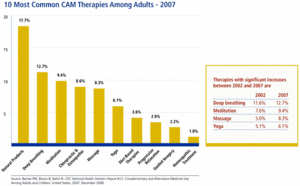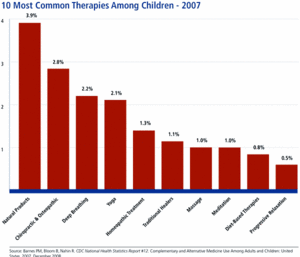According to the latest federal survey on complementary and alternative medicine (CAM) utilization in the U.S., nearly four in 10 adults (38.3 percent) and one in nine children (11.8 percent) use CAM, and musculoskeletal conditions constitute the number-one reason for visiting a CAM provider. In fact, "back pain or problem" and "neck pain or problem" rank first and second in terms of conditions for which adults use CAM therapies (17.1 percent and 5.9 percent, respectively), while "back or neck pain" is the second most common reason for child CAM use (6.7 percent of children). This marked the first time CAM use among children has been evaluated by the government.
"Complementary and Alternative Medicine Use Among Adults and Children: United States, 2007," conducted by the National Center for Complementary and Alternative Medicine (NCCAM) and the National Center for Health Statistics as part of the 2007 National Health Interview Survey (NHIS), charted the changes in CAM use since 2002, the last time the survey was performed. In total, 23,393 adults ages 18 or older and 9,417 children were surveyed, giving data on utilization of 36 different therapies (nine more than the 2002 survey) within the previous 12 months.
Top CAM Therapies Used
According to the survey, "nonvitamin, nonmineral, natural products" was the most common CAM approach used by both adults and children. Chiropractic or osteopathic manipulation was fourth on the list for adults, behind deep breathing exercises and meditation, and second on the list for children.
 Comparing 2007 survey results with 2002 findings and extrapolating both to the general population, in 2002, more than 15 million adults (7.5 percent of the population) used "chiropractic care"; in 2007, nearly 19 million (8.6 percent) used "chiropractic or osteopathic manipulation." While a direct correlation cannot be drawn between the 2002 and 2007 numbers, since the latest survey lumps chiropractic and osteopathic manipulation together, there seems to be no doubt that manipulation therapies are popular with CAM users. In 2007, 2.8 percent of children under the age of 18 (approximately 2 million children) used chiropractic or osteopathic manipulation.
Comparing 2007 survey results with 2002 findings and extrapolating both to the general population, in 2002, more than 15 million adults (7.5 percent of the population) used "chiropractic care"; in 2007, nearly 19 million (8.6 percent) used "chiropractic or osteopathic manipulation." While a direct correlation cannot be drawn between the 2002 and 2007 numbers, since the latest survey lumps chiropractic and osteopathic manipulation together, there seems to be no doubt that manipulation therapies are popular with CAM users. In 2007, 2.8 percent of children under the age of 18 (approximately 2 million children) used chiropractic or osteopathic manipulation.
Conditions Treated With CAM
As mentioned, adults used CAM most often to treat a variety of musculoskeletal problems, including many conditions managed routinely by chiropractors: back pain or back problems , neck pain or neck problems, joint pain or stiffness, arthritis, headaches and sprains/strains. Conditions for which children most often used CAM in the past 12 months included back or neck pain, head or chest colds, anxiety or stress, other musculoskeletal problems, and attention-deficit/hyperactivity disorders. Looking specifically at musculoskeletal conditions, this translates to 705,000 children using CAM for back or neck pain and an additional 378,000 using it for other musculoskeletal issues.
General CAM User Profile
 According to the survey, "[I]n 2007 CAM use was more prevalent among women, adults aged 30-69, adults with higher levels of education, adults who were not poor, adults living in the West, former smokers, and adults who were hospitalized in the last year." Additionally, those with private insurance were more likely to use CAM than those under Medicare or with no insurance. This was consistent with 2002 survey findings. In general, child users were more likely to be Caucasian, older (12-17 years of age) and have parents with higher education and income levels who also utilized CAM.
According to the survey, "[I]n 2007 CAM use was more prevalent among women, adults aged 30-69, adults with higher levels of education, adults who were not poor, adults living in the West, former smokers, and adults who were hospitalized in the last year." Additionally, those with private insurance were more likely to use CAM than those under Medicare or with no insurance. This was consistent with 2002 survey findings. In general, child users were more likely to be Caucasian, older (12-17 years of age) and have parents with higher education and income levels who also utilized CAM.
In a statement to the press, Josephine P. Briggs, MD, director of the NCCAM, emphasized the importance of the latest survey findings: "The 2007 NHIS provides the most current, comprehensive, and reliable source of information on Americans' use of CAM. These statistics confirm that CAM practices are a frequently used component of Americans' health care regimens, and reinforce the need for rigorous research to study the safety and effectiveness of these therapies. The data also point out the need for patients and health care providers to openly discuss CAM use to ensure safe and coordinated care."
To view complete survey results, as well as various charts capturing the data, please visit http://nccam.nih.gov/news/camstats.htm.




